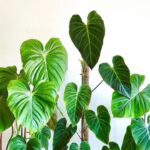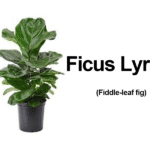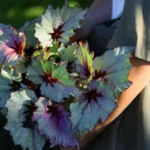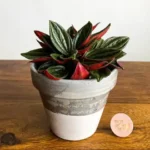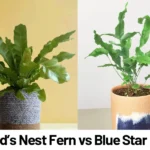Meet the Jewel of the Jungle: Alocasia Reginula
Among tropical houseplants, few command attention quite like Alocasia reginula, affectionately known as the Black Velvet. With its deep green to almost black leaves and contrasting silvery veins, this compact aroid is a true jewel for any indoor plant collection. Originating from the humid forests of Borneo, this plant thrives in warm, moist environments, making it a stunning but slightly finicky addition to any indoor garden.
In this guide, we’ll explore everything you need to know about Alocasia reginula, including how to care for it, common problems, propagation tips, and practical advice to keep your plant healthy and thriving.
Understanding Alocasia Reginula
Alocasia reginula belongs to the Araceae family and differs from larger Alocasias like the more well-known Alocasia amazonica in its smaller size and velvety leaf texture. It typically grows no more than 12 to 18 inches tall, making it ideal for shelves, tabletops, or even terrariums. Despite its size, it packs plenty of visual impact with its dramatic foliage.
Its nickname “Black Velvet” isn’t just poetic – the plant truly has a luxurious appearance. The leaves are heart-shaped, rich in color, and have a velvety feel. The silver-white veins create a striking contrast that sets it apart from other foliage plants.
Ideal Growing Conditions
Alocasia reginula requires specific environmental conditions to thrive. While not the easiest plant for beginners, with the right care, it’s rewarding and reliably beautiful year-round.
Light Requirements
This plant prefers bright, indirect sunlight. Direct sun can scorch its delicate leaves, while too little light can cause leaf loss and stunted growth.
- Place near an east-facing window for gentle morning sun.
- In darker rooms, supplement with grow lights to maintain healthy growth.
- Rotate the plant occasionally to ensure even growth on all sides.
Temperature and Humidity
As a tropical plant, Alocasia reginula thrives in warm and humid environments. Keep it consistently warm and never expose it to cold drafts or temps below 60°F (15°C).
- Ideal temperature range: 65–80°F (18–27°C).
- Humidity: Above 60% is best. Use a humidifier or place the plant on a pebble tray filled with water for better moisture.
- Avoid placing near radiators or air conditioners that dry out the air.
Soil and Potting
Like many aroids, the Black Velvet enjoys well-draining, slightly acidic soil. A light, airy mix will keep the roots happy and reduce the risk of rot.
- Recommended mix: equal parts peat moss or coco coir, perlite, and orchid bark.
- Use a pot with drainage holes to prevent water accumulation.
- Repot every 1–2 years in early spring if the plant outgrows its container.
Watering Routine
Watering Alocasia reginula correctly is crucial. It prefers evenly moist soil but can suffer from root rot if overwatered. During its active growth in warmer months, expect to water more frequently.
- Check the top inch of soil before watering—it should feel dry to the touch.
- In winter, reduce watering to once every two weeks or when the soil is mostly dry.
- Use room-temperature, filtered water to avoid leaf burn from minerals or cold shock.
Routine Care and Maintenance
Feeding and Fertilization
To support healthy foliage growth, you can fertilize during the growing season. Use a balanced houseplant fertilizer diluted to half strength every 4–6 weeks from spring to early fall.
Skip fertilization during winter dormancy to prevent buildup of salts and root burn.
Pruning and Cleaning
Prune yellowing or damaged leaves with clean shears to encourage new growth and maintain beauty. Gently wipe leaves with a soft cloth to remove dust and enhance photosynthesis.
Pest Management
Alocasia reginula is vulnerable to common indoor pests like spider mites, mealybugs, and aphids, especially in dry conditions.
- Inspect newly acquired plants and routinely check undersides of leaves.
- Use a neem oil spray or insecticidal soap if infestations occur.
- Boost humidity to deter pests, as many thrive in dry environments.
Common Problems and How to Fix Them
Even attentive plant lovers can encounter issues. Here are a few common troubleshooting tips for Black Velvet care:
Yellowing Leaves
This is often a sign of overwatering or poor drainage. Allow soil to dry slightly more between watering and ensure the pot has drainage holes.
Drooping Leaves
Could be caused by under-watering, shock from cold air, or root rot. Reassess the watering schedule and environmental conditions.
Leaf Edges Turning Brown
Usually due to low humidity or buildup of fertilizer salts. Increase ambient moisture and flush soil with distilled water to reduce chemical residue.
Slow Growth
This can be normal in winter when the plant enters a semi-dormant state. Growth will resume in spring; avoid overwatering during this period.
Propagation and Growth Tips
Unlike some other houseplants, Alocasia reginula cannot be propagated through stem cuttings or leaf division. Instead, it reproduces primarily through rhizome offsets or corms, which grow beneath the soil line.
Steps to propagate:
- Wait until the plant produces offsets or small baby plants at the base.
- When repotting in the spring, gently separate offsets from the main plant, ensuring each section has roots attached.
- Pot the offset in a similar well-draining mix and maintain high humidity to encourage root establishment.
This slow propagation method means patience is key, but it’s a meaningful way to share this beautiful plant with friends or grow your indoor foliage collection.
Conclusion
Alocasia reginula is a stunning compact plant that brings sophistication and a touch of the exotic jungle into your home. While it may require a bit more care and attention than beginner-friendly houseplants, the reward is worth it: mesmerizing foliage that easily becomes a focal point of any plant collection.
By providing the right balance of light, humidity, water, and warmth, and tending to its unique needs, you can enjoy the beauty of the Black Velvet for years to come. Don’t be discouraged by minor setbacks—tuning into your plant’s signals and adjusting your care routine will lead to a thriving Alocasia any plant lover would be proud of.
References
- Boyce, P. C., & Croat, T. B. (2011). The Überlist of Araceae. Missouri Botanical Garden. https://www.aroid.org
- Engel, V. (2020). The Houseplant Encyclopedia. Urban Gardeners Guild Press.
- Graham, D. (2018). Botany for Houseplant Lovers. Green Thumb Publications.


